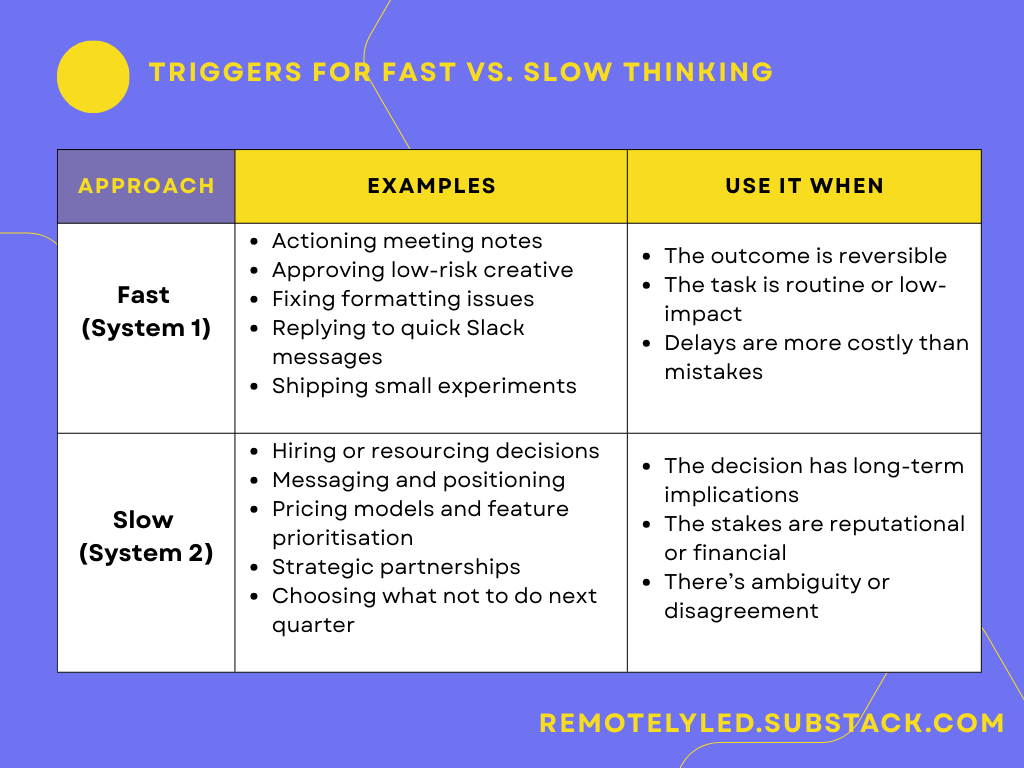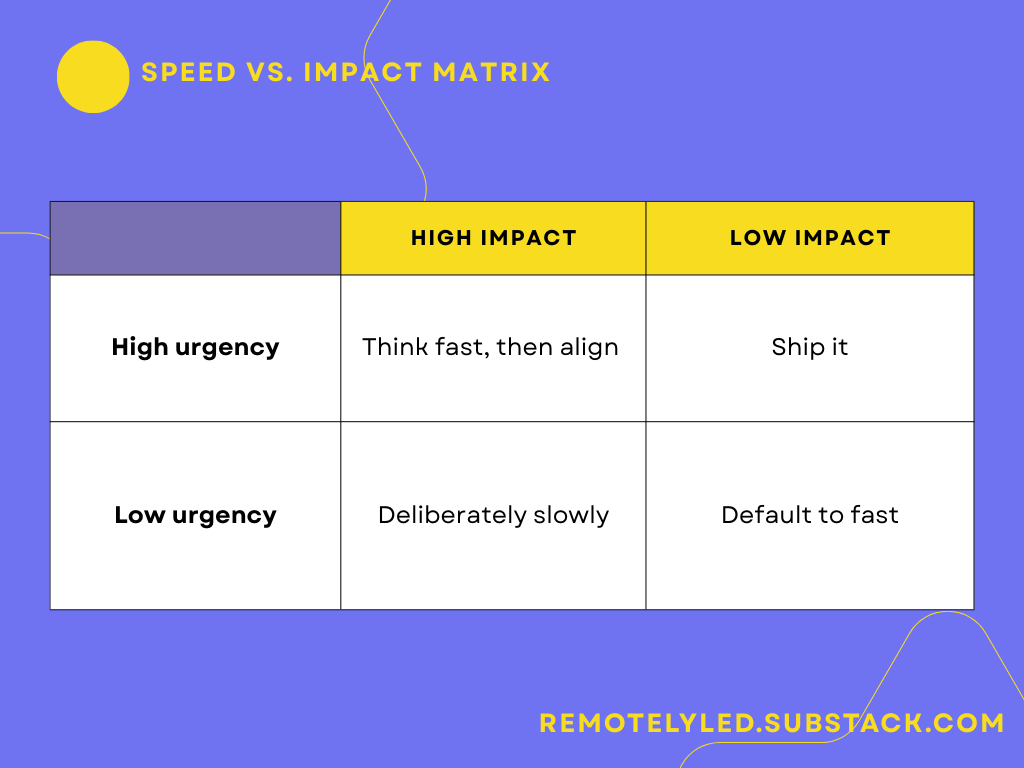Working Fast and Slow: How to decide better in remote teams
Why great remote leaders coach decisional pace, not just decisions.
“Nothing in life is as important as you think it is while you are thinking about it.” — Daniel Kahneman
It’s one of those truths you feel every day when working remotely, especially when you’re bouncing between tasks, channels, and decisions that all feel urgent in the moment.
So how do you know what really matters? When do you rush, and when do you pause?
That’s where the idea of working fast and slow comes in.
The remote reality of a thousand micro-decisions
Working remotely means making constant decisions from high-level strategic calls to micro-level details (like where to place a comma).
Especially in marketing, your brain is constantly switching contexts: one moment it’s about campaign performance, the next it’s reviewing copy or briefing a new piece of content.
It’s a lot.
And the reality is, many marketers (and high performers) operate with a unique blend of creativity and analytical thinking…
Basically a supercharged brain that thrives in ambiguity.
The additional layer is this: you need to know when to make the decisions fast and when to pause and think slow.
Let’s say you have a landing page go live. It’s getting solid traffic but no conversions.
You know something’s off, but you’ve already workshopped the headline for two weeks.
Was it the layout? The CTA?
You could easily spend another two weeks debating it.
But instead, you try something quick.
You run two headline variants.
One's a hunch from your designer. The other is a throwaway suggestion from the intern.
The intern’s version wins.
Not what you would’ve come up with in a big brainstorm.
But it worked.
That’s fast thinking. And it has its place.
Fast vs slow thinking: A mental model for remote teams
Psychologist Daniel Kahneman’s Thinking, Fast and Slow introduces a foundational framework for how we think:
System 1: Fast, instinctive, automatic, emotional. Useful for rapid decisions like spotting a typo or reacting in a crisis.
Fast, intuitive, automatic, emotional
Operates effortlessly and constantly
Example: Answering “2+2” or recognising a familiar face
System 2: Slow, deliberate, logical. Useful for complex or high-stakes thinking like writing strategy docs or evaluating trade-offs.
Slow, deliberate, effortful, analytical
Engaged when complex reasoning or focus is required
Example: Solving “17 × 24” or filling out a tax form
“System 1 operates automatically and quickly, with little or no effort and no sense of voluntary control. System 2 allocates attention to the effortful mental activities that demand it.” — Daniel Kahneman
In remote teams, where communication is mostly async and decisions are made across time zones, knowing which system to use becomes essential.
Use System 1 when speed and instinct are required.
Use System 2 when stakes are high, ambiguity is present, or long-term impact is involved.
The danger is that biases creep in when System 1 jumps in too quickly, and bottlenecks form when System 2 takes over what should be fast, simple calls.
The trap: Remote work amplifies the noise
Remote work fragments attention. Slack messages. Loom updates. Email threads. Comments on Figma. It’s constant.
More inputs = more micro-decisions = more decision fatigue.
Without clarity from leaders on when to act quickly and when to think deeply, teams:
Overthink low-stakes tasks
Rush through important ones
Get stuck in indecision
And as a leader, you're not just making decisions—you’re modelling how to make them.
“If a satisfactory answer to a hard question is not found quickly, System 1 will find a related question that is easier—and answer it.” — Kahneman on substitution bias
This shows up when someone asks, "Should we pivot this campaign?" and the team answers a simpler question instead: "Do I like the ad?" Aesthetic preference becomes a stand-in for strategy.
It’s also common during product feedback. If you ask users what they think, they might say “I like it” not realising that’s not the question.
What you really want to know is: “Will you pay for this?”
But that’s a harder question so both parties default to the easier one.
System 2 helps keep you focused on the real decision, not just the convenient one.
When to work fast: Moments for instinct and momentum
System 1 thinking relies heavily on heuristics—mental shortcuts that help us move quickly, but not always accurately.
These shortcuts often lead to common biases that can throw off our judgement without us realising it.
System 1 is your “just do it” mode. Use it when the cost of being wrong is low or when momentum matters more than perfection.
Examples:
Actioning meeting notes
Approving low-risk creative
Fixing formatting issues
Replying to quick Slack messages
Shipping small experiments
Use it when:
The outcome is reversible
The task is routine or low-impact
Delays are more costly than mistakes
Framework: If it’s low cost and reversible—ship it.
Beware of bias:
Availability bias: Prioritising what’s loudest or most recent—like rebuilding a feature because one client complained about it.
Anchoring: Latching onto the first data point you see—like setting campaign budget based on last month without evaluating new variables.
“System 1 is radically insensitive to both the quality and the quantity of the information that gives rise to impressions and intuitions.” — Kahneman
When to work slow: Moments for pause and depth
There are times when slowing down saves you from future chaos. But it’s also when you need to push against your instincts, especially when they’re being shaped by biases.
Take pricing decisions, for example. It’s tempting to go with what "feels right"—a number that sounds competitive or familiar. That’s often System 1 using anchoring bias: we latch onto the first figure we’ve seen, even if it’s outdated or irrelevant.
Or think about first impressions in a client meeting. You might instantly decide whether they’re aligned with your offer or not—because your brain is shortcutting with limited data. That’s availability bias in action.
System 2 is what helps you pause and ask: Do I have enough information? Or am I resisting what the data actually shows me?
"System 1 is radically insensitive to both the quality and the quantity of the information that gives rise to impressions and intuitions." — Kahneman
Sometimes, you need to slow down to be faster in the long run.
A rushed decision might save a day, but cost you a week cleaning up the consequences (bugs, misunderstandings, backpedals).
Slowness can be its own kind of speed when it prevents rework up and down the pipeline.
System 2 is your strategy gear. It protects against blind spots, bias, and bad bets.
Examples:
Hiring or resourcing decisions
Messaging and positioning
Pricing models and feature prioritisation
Strategic partnerships
Choosing what not to do next quarter
Use it when:
The decision has long-term implications
The stakes are reputational or financial
There’s ambiguity or disagreement
Watch for overconfidence:
Marketing teams often believe they understand the customer perfectly. But without deliberate reflection, assumptions go unchallenged.
System 2 thinking forces you to check: Are we assuming this message will land? Or have we validated it?
“Losses loom larger than gains.” — Kahneman
This bias (loss aversion) shows up when teams avoid changing tools or shifting strategy. Not because the status quo is good, but because the pain of change feels bigger than the potential upside.
It also explains why fear-based messaging often gets more attention and why discounts work better than equivalent bonuses.
Helping your team switch gears
Great remote leaders don’t just decide well. They coach how to decide.
Tips:
Label the pace: "This one’s a fast decision." vs. "Let’s slow this down."
Set default modes: Creative reviews = slow. Admin = fast.
Protect time for System 2 thinking: No-meeting blocks, async reviews, longer deadlines.
Normalise speed for low-stakes work: Not everything needs a doc.
You’re helping your team build a decision muscle.
Your decision muscle toggles between fast and slow with intent.
Speed vs. Impact Matrix
Should I work fast or slow on this?
Use this as a gut check when deciding how much time a task deserves.
Decision pace is a leadership skill
Working fast isn’t careless. Working slow isn’t inefficient.
The real power lies in knowing when to speed up and when to slow down—and helping your team do the same.
“Nothing in life is as important as you think it is while you are thinking about it.” — Daniel Kahneman
That line stuck with me.
It’s one of those truths you feel every day when working remotely—especially when you’re bouncing between tasks, channels, and decisions that all feel urgent in the moment.
So how do you know what really matters? When to rush, when to pause?
That’s where the idea of working fast and slow comes in.
Get that right, and you won’t just make better decisions. You’ll build a team that:
Thinks more clearly
Ships more confidently
Moves with deliberate momentum
What’s your take? Where have you seen fast vs. slow thinking go really well (or badly) in your team?
I’d love to hear from you. Just hit reply and share your thoughts.




